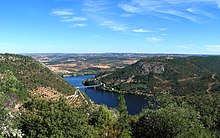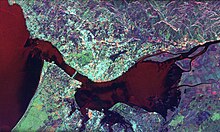Tagus
You can help expand this article with text translated from the corresponding article in Spanish. (April 2009) Click [show] for important translation instructions.
|
| Tagus | |
|---|---|
 View of Tagus River in Toledo, Spain | |
 Path of the Tagus through the Iberian Peninsula | |
| Etymology | Vulgar Latin taliāre, "to cut through" |
| Location | |
| Country | Spain, Portugal |
| Physical characteristics | |
| Source | Fuente de García, Montes Universales |
| • location | Frías de Albarracín, Spain |
| • coordinates | 40°19′16″N 1°41′49″W / 40.321°N 1.697°W |
| • elevation | 1,593 m (5,226 ft) |
| Mouth | Estuary of the Tagus, Atlantic Ocean |
• location | Lisbon, Portugal |
• coordinates | 38°41′28″N 9°10′16″W / 38.691°N 9.171°W |
• elevation | 0 m (0 ft) |
| Length | 1,007 km (626 mi) |
| Basin size | 80,100 km2 (30,900 sq mi) |
| Discharge | |
| • average | 500 m3/s (18,000 cu ft/s) |
| Basin features | |
| Tributaries | |
| • left | |


The Tagus (/ˈteɪɡəs/ TAY-gəs; Spanish: Tajo [ˈtaxo]; Portuguese: Tejo [ˈtɛʒu]; see below) is the longest river in the Iberian Peninsula. The river rises in the Montes Universales near Teruel, in mid-eastern Spain, flows 1,007 km (626 mi), generally westward, and empties into the Atlantic Ocean in Lisbon.[1]
Name
The river's Latin name is Tagus. While the etymology is unclear, the most probable etymological origin for the
Geology
The lower Tagus region in Portugal is a seismically active area. Major earthquakes in the Lower Tagus include those of 1309, 1531, and 1909.[3][4]
Inverted Delta

Tagus river is one of the few rivers in the world to have an inverted delta. Its delta is wider at the beginning and narrows down as it approaches the sea, contrary to a typical delta. This is because it flows into the sea through a small opening in a valley. Although due to sedimentation this delta is now only very partially inverted, with the valley now mostly filled with sediment. The delta is about 15 km wide and 25 km long, but its exit into the sea is only 2 km wide. It thus forms a large lagoon with large and very shallow sand banks which go uncovered during low tides. The delta used to be even bigger thousands of years ago.
History

The Pepper Wreck, properly the wreck of the
The Tagus river basin comprises 42 River Nature Reserves [es] and is the river basin with the most protected areas in Spain.[1]: Prefacio
See also
- List of rivers of Spain
- List of rivers of Portugal
 Media related to Tagus River at Wikimedia Commons
Media related to Tagus River at Wikimedia Commons
References
- ^ OCLC 1376251354.
- .
- ^ Hobbs, William Herbert (1907). Earthquakes: An Introduction to Seismic Geology. New York: D. Appleton and Company. pp. 142–144. Downloadable Internet Archive
- ^ "Sismo sentido em Lisboa na mesma zona dos grandes abalos de 1531 e 1909" [Earthquake felt in Lisbon in the same area as the great earthquakes of 1531 and 1909] (in Portuguese). Diário de Notícias. 18 March 2021. Retrieved 29 October 2021.
- OCLC 56517607.
